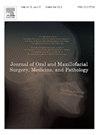A case report of apexification using mineral trioxide aggregate
IF 0.4
Q4 DENTISTRY, ORAL SURGERY & MEDICINE
Journal of Oral and Maxillofacial Surgery Medicine and Pathology
Pub Date : 2024-09-10
DOI:10.1016/j.ajoms.2024.09.006
引用次数: 0
Abstract
Mineral trioxide aggregate (MTA) is an excellent biocompatible material that can seal intra- and extra-root canal spaces via hard tissue formation. However, the biological mechanism of hard tissue formation is still unclear. This study aims to investigate the biological mechanism of hard tissue formation by MTA in apexification. A 9-year-old boy visited to Asahi University medical dental center complaining of spontaneous pain in tooth #7. #7 was immature tooth and dens invaginatus. At first, we tried to performe apexogenesis because we diagnosed pulpitis, but 2 days after the treatment, dental pulp necrosis later occurred, so we performed apexification using MTA. Unfortunately, the tooth was extracted because of external root resorption after apexification. We explored the potential for MTA to conduct hard tissue formation from apical periodontal tissue into the root canal. The formalin-fixed tooth was subjected to volume of mineral density (VMD) analysis by micro-computed tomography (µCT). After decalcification, the specimen was embedded in paraffin and sliced into thin sections. VMD and histological analyses revealed regions of moderate-/high-mineral-density bony hard tissue and bone marrow tissue, along with vacuolar cell clusters. Immunohistochemical analyses of bony-like hard tissue revealed immunopositivity for osterix and dentin matrix acidic phosphoprotein 1 (DMP1). Moreover, vacuolated cells were immunopositive for CD68 and CD163, but immunonegative for DMP1, osterix, and negative staining for TRAP. Our findings suggested that apical closure was caused by MTA with osteoconduction via CD68-positive/CD163-negative M1-like macrophages (foreign body response) and CD163-positive M2 macrophages (tissue repair and regeneration) derived from apical periodontal tissue.
求助全文
约1分钟内获得全文
求助全文
来源期刊

Journal of Oral and Maxillofacial Surgery Medicine and Pathology
DENTISTRY, ORAL SURGERY & MEDICINE-
CiteScore
0.80
自引率
0.00%
发文量
129
审稿时长
83 days
 求助内容:
求助内容: 应助结果提醒方式:
应助结果提醒方式:


